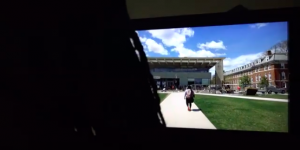Part I. The Plot
Sequence 1 A young, Black woman wakes up to start her day. Through narration, we learn that her name is Jay and she is college student who is very active on her campus.
Sequence 2 Immediately after waking up, Jay turns off her alarm and checks her phone. She scrolls through Tinder and Groupme, updating herself on what has happened overnight.
Sequence 3 After getting out of bed, Jay continues checking her social media while getting ready for her day. Leaving her room and heading to class, she listens to “Act Up” by the City Girls.
Sequence 4 After class, Jay walks to Paresky to do work. While sitting in Lee’s, her friend approaches her and shows her a meme that she has already seen. They laugh.
Sequence 5 Next, it is time for Jay to do what she does every day–surf the web.
Sequence 6 At a meeting for her group project, Jay and her friends discuss how digital technologies reinscribe and/or eliminate distinctions of race. Jay mentions how there could be a special curator deciding what we see, which we then use to learn about different races and cultures.
Sequence 7 After her meeting, Jay returns to her dorm room and gets ready for bed. As she is in bed, she scrolls through social media on her laptop one last time.
Sequence 8 While she is sleeping, the camera that has been watching her all along zooms in on her face.
Sequence 9 Next, an unknown person watches Jay’s day unfold on screen. (256 words)
Part II. Scene Selection & Analysis (7:10)

In this frame, we see an unknown figure watching Jay as she walks from class to Paresky. The camera, while filming from behind, is shooting the scene from eye-level which allows for audience members to see exactly what the mystery man (or woman) is seeing from the same perspective. Due to the camera’s positioning, we can only see that there is a person, but we cannot tell who they are.
Right before this scene, Jay speaks to her friends as they work on a group project. They speak about whether or not digital technologies affect our understandings of race to which Jay says that they do and that there could possibly be someone watching what we do to determine what it is that we see on social media. The current scene displayed above addresses just that. The person watching Jay throughout her day could be perceived as the curator of Jay’s social media content. As he or she is watches Jay navigate the spaces of her school, they use her interactions with those around her, as well as past data from her social media activity, to craft what Jay will see the next time she is on her phone. What Jay then sees will determine how she understands the world around her, but especially race.
On the other hand, with the camera’s orientation as is, the identity of the anonymous viewer is open to interpretation and could be assumed to be a random person who is watching Jay and actively surveilling her. Considering cameras everywhere and almost all social media platforms allow us to record, the anonymous viewer could have received this footage from anywhere. While, the information collected from watching Jay will not be used to construct her timeline, it encourages the viewer of our multimedia narrative to be wary of what they do and post because there is always someone watching. While this is unsettling, it reveals the dangers of today’s digital technologies. (325 words)
